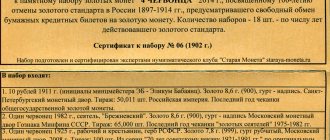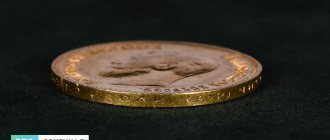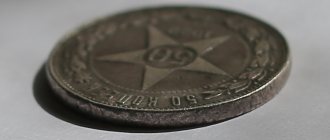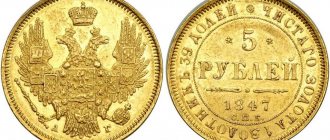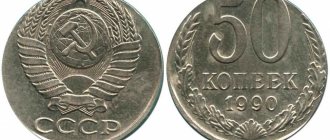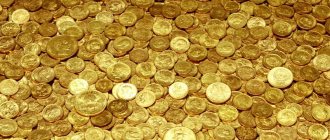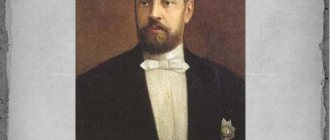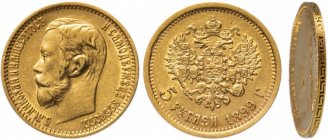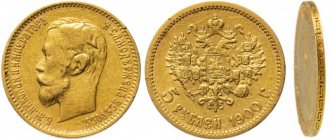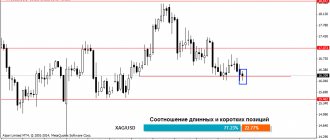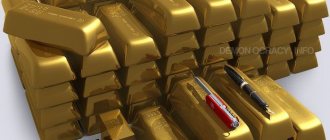The ruble is gradually depreciating, the exchange rate of other currencies, like precious stones, is unstable and often fluctuates, housing is becoming dilapidated. Owners of gold coins that circulated in the last or the century before hope for high profits from their antiques. In the article we will look at how much the royal chervonets made of gold with the image of Nicholas 2 costs today.
Story
The gold ten of 1901 issue appeared thanks to the monetary reforms of Yu. Witte. In order to improve the economic situation of the state, the Minister of Finance introduced the backing of the ruble in gold.
Without detracting from the dignity of the coin, it should still be said that this is just a two-centimeter gold circle. In pre-revolutionary Russia, it was a common banknote for payments between buyers. It was freely exchanged for paper money and vice versa. Historians claim that the Russians were not very fond of them because of their small size and the inconvenience associated with them. Ask yourself which is easier to lose: a small gold round or a large paper bill, and the answer will become obvious.
But hiding treasures with “royal chervonets” was very convenient. This is probably the reason for the numerous stories and legends about treasures, inherited wealth and criminal crimes associated with this coin.
The gold tenth originally weighed 12.9 grams and was pegged to silver. With the appearance in circulation of the gold chervonets of Nicholas II of 1901, 10 rubles were equated to pure gold weighing 7.8 grams (rounded).
Profitable investment in royal coins
Like any antique, coins from past centuries only increase in value with the passage of time. According to the dynamics of the exchange rate, it is time to say with confidence that the sale of Nikolaev gold coins can be much more expensive than the cost for which they were purchased.
Buying, as well as selling, royal chervonets is not at all difficult. This is partly true, but you should be prepared for what you will need:
- a substantial amount for the initial purchase of coins;
- excellent knowledge of the history and numismatics of that time and the ability to navigate antiques well.
The authenticity of the royal 10-ruble coin must be confirmed by a special certificate. Among other things, don’t be afraid to ask the seller for the document. In addition, to avoid falling into the hands of scammers, some rules will help. First of all, you should buy royal money exclusively from a seller who has a good reputation. For this purpose, you can register on numismatic forums. There are few responsible sellers; online resources contain data regarding problematic transactions.
Characteristics
Due to the fact that the gold was 900 fine, the total weight of the coin released into circulation was slightly higher.
Each piece was minted with the following characteristics:
- weight – 8.6 g (Au – 7.74 g);
- diameter – 22.5 mm;
- thickness – 1.7 mm;
- metal – 900 gold;
- edge – smooth with inscription;
- magnetic properties – diamagnetic.
The total circulation of ten-ruble coins in 1901 is 2.377 million pieces.
Obverse
In the center of the coin is depicted in profile (left view) Emperor of Russia Nicholas II. Along an arc along the right edge of the coin (to our left) is the inscription in capital letters: “B.M. NICHOLAS II EMPEROR." On the left side (to our right) the second part of the inscription is symmetrically located: “AND THE AUTODER OF ALL RUSSIA.” The last word is shortened to avoid breaking the symmetry on the obverse of the coin. The text is written in a font and letters characteristic of the pre-revolutionary alphabet and used in writing until the reform of 1918.
The edging vaguely resembles a gear with internal teeth, but the teeth are not pointed, but patterned with spherical thickenings at the end. This collar was intended to add artistic beauty to the coin and provide additional protection against counterfeiting.
Reverse
The main part of the reverse side of the ten is filled with the coat of arms of Russia. The double-headed eagle is crowned with three crowns. Two small ones are on the heads of the birds, and the large one is located slightly higher in the middle of this pair. A shield with the image of a horseman - St. George the Victorious, striking a serpent with a spear, covers the chest of the bird. On the order chain bordering the shield, the highest award of the Russian Empire is the Order of St. Andrew the First-Called Apostle.
The eagle's wings are spread open as if to take off. On their background there are 4 coats of arms on each side. Each of which symbolizes a large principality or kingdom within the empire. Against the background of the right wing (for us on the left):
- Siberian;
- Georgian;
- Kyiv and Novgorodskoe;
- Vladimirskoe.
Against the background of the left wing (for us on the right):
- Kazanskoe;
- Polish;
- Tauride;
- Astrakhan.
In the eagle's claws are royal regalia, personifying power. This is a scepter in the right paw and an orb in the left.
Below in a semicircle is an inscription in pre-revolutionary font: “10 rubles 1901.”
The entire composition of the reverse is bordered by a patterned shoulder with rounded teeth along the edge of the coin.
edge
The edge of the coin is smooth, but there is an inscription on it: “PURE GOLD 1 GOLD 78.24 SHARES.” The initials of the mintmeister (the official responsible for minting coins) are also present here.
Personal responsibility gave the right to apply a name mark, which was placed on the end of the coin. In the year of minting ten rubles in 1901, the mintmasters of the mint were two people in turn. The first, Felix Zaleman, served as head of the mint from 1899 to 1901, and the second, who replaced him, Alexander Redko.
This circumstance explains the presence of two pairs of initials on the edge - FZ and AR.
The rarest and most expensive gold coins of the era of Nicholas II
The highest prices are found in copies whose production was not in the millions, but in hundreds or even tens of pieces. In addition to donated coins, we can highlight gold 5 and 10 rubles issued from 1905 to 1907, since at that time, due to the Russo-Japanese War and after the revolution, Nicholas II ordered the minting of money from precious metals to be reduced to minimum circulations. Thus, in 1906, only 10 pieces of gold 5 and 10 rubles were produced, and in 1907, 109 gold fives were issued.
Expert opinion
Alexander Ivanovich
Private collector with 4500+ coins and bonds in his personal collection. Knows the value of each of them today.
Most coins of the Nicholas era were issued in colossal, million-dollar quantities, since they were intended for cash payments. Not many copies have survived in excellent condition. Such items are especially highly valued.
A unique example of coins from the time of Nicholas II, without exaggeration, is test banknotes - russ. They did not go into circulation, but 5 sets were produced.
Soviet gold chervonets
A separate group are the “royal chervonets” of the Soviet coinage. Considering them a variety or classifying them as fakes is a rather problematic issue. There is no definite opinion on this matter.
The fact remains that for two years, from 1925 to 1926, the Leningrad Mint secretly minted gold coins in denominations of 10 rubles of the 1901 model.
The work was carried out in three shifts, and overtime was used if necessary.
The details of this secret special order have been preserved:
- December 1925 - 600,000 units;
- January 1926 - 411,000 units;
- February 1926 - 100,000 units;
- March 1926 – 900,000 units.
The result of the work was the release of 2,011,000 gold ten-ruble notes, analogues of the Tsar's chervonets.
Despite the fact that the minting was carried out very carefully and using equipment left over from pre-revolutionary times, the samples of the remake have characteristic differences. The likely reason is the use of stamps that have not been used before. The loss of the previous stamps did not allow achieving perfect similarity, and a number of significant differences make it easy to distinguish the original from the tsarist ten Soviet years of issue.
The differences relate to the obverse, which is different in size, wide outer edge and other details from the obverse of the old stamp. If numismatists call a pre-revolutionary portrait a “big head,” then the profile of the head of Emperor NICHOLAS II on Soviet samples is significantly smaller than its 1901 counterparts and is called a “small head.” The curve of the neck at the back of the head is more oval, for which among collectors the image received the apt name “light bulb” and the less common “Italian”.
Another difference between the “Soviet-Tsarist” chervonets is the details on the edge. They concern the brackets that contained the initials of the mintzmeister. On the edge of Soviet minted coins they stand much further from the letters. The letters themselves are also different. On pre-revolutionary banknotes the letter P is made in a perfect semicircle; on Soviet examples it looks triangular, like the letter G was minted by adding an additional stroke. There are also differences in the shape of the letter “Z” in the word forms “gold” and “zolotnik”. Soviet analogues are distinguished by more rounded ends, in contrast to the straightened ends of the letter “Z” on pre-revolutionary chervonets.
The massive circulation of coins from the bygone autocracy was explained by political and economic reasons, which the young Soviet government solved in such a unique way. In international payments, foreign countries refused to accept Soviet chervonets, making claims about the low quality of gold. But the royal ten-ruble notes were accepted very willingly. Another reason is that the cost of the imperial tens was significantly lower than the Soviet ones, so foreign partners accepted them more willingly.
Thus, with the help of the massive circulation of pre-revolutionary gold chervonets, the Soviet state was able to overcome the “golden blockade” of capitalist countries on the foreign economic market.
The cost of “remakes” is easy to calculate on your own: (exchange price of 1 gram of gold) x 0.9 (fineness coefficient 900) x 8.6 (weight of a gold chervonets) + 2-5% (numismatic markup if the buyer agrees to pay for Soviet coinage) = cost remake coins. See below for the real cost of the royal original.
Counterfeits of royal chervonets
10 rubles of Nicholas II are counterfeited, like many coins of the Tsarist period. Typically, copies have a smaller purity (this is the economic sense of counterfeiting ordinary chervonets), which is reflected in the overall dimensions of the coin, since by reducing the purity and in order to comply with the standard weight of 8.6 grams, it will be necessary to fill a larger volume of the intended coin with metal, since most of the available metals lighter than gold. Of course, you can do some of the checks yourself, but the best way to avoid situations with counterfeits is to carefully choose a consultant or coin seller, while having knowledge that will partially allow you to understand what is being checked and how. It should be noted that not often, but there are fakes in which the approximate fineness and dimensional characteristics of the original coins are observed. By purchasing such a coin, you will receive an item that will actually sell on the market for 10-15% less than the metal in it - this is actually selling a copy as a piece of metal, with a discount from the exchange price of gold, which, as a rule, pawnshops take in that or in another form, if they come across a product (genuine coin) that is not stamped (jewelry) or has not left the mint, which (genuine coin) has also been formally tested (by manufacturing technology at the mint).
Price
The cost of a 10 ruble gold coin from 1901 largely depends on a number of factors. Some have a slight effect, others can significantly reduce or increase the price tag:
- Instance state. This factor is given primary attention. For example, a poorly preserved specimen (G) will be much cheaper than a chervonets in excellent condition (MS);
- Place of purchase. The cost at auction or from the hands of an intermediary are often completely different things. If at auction the price depends on demand, then the intermediary strives to earn as much as possible from the service;
- Delivery method, terms of purchase. These details are discussed individually by the parties to the transaction, based on the results of which the final price is determined;
- Time to buy. The price of coins increases over the years, and if it is also spurred by active demand, then the cost can increase significantly. The quotation of precious metals also plays an important role.
Below is a table of the average cost of the coin “10 rubles 1901 AR or FZ” at auctions.
| Coin | Price in rubles |
| Federal Law | 40000 |
| AR | 80000 |
| Soviet coinage | 80000 |
A study of auctions shows that the starting price can sometimes start at 1000 rubles, but the bids for the lot end up being at the level of the average price from the table. We should not forget that value is a conditional thing, therefore the final price for a coin is set directly by the seller and buyer, with mandatory confirmation of the authenticity of the sample if the transaction takes place outside of the auction.
Where can you buy or sell
A common and reliable way to buy or sell antique gold coins is through auction houses. They not only organize auctions, but also conduct examinations and evaluations of samples, so there is no chance of getting a fake. And such items are very often counterfeited due to their high cost. The most reputable auction house selling numismatics is Wolmar.
Buying and selling money from the era of Nicholas II is the prerogative of antique and numismatic stores. Experienced treasure hunters try to avoid these traders, since they rarely offer a decent price for the goods. But there are exceptions, for example the famous “Numismatist” and the adjacent flea market in Moscow.
Another way to buy or sell antique gold is through numismatic societies and portals. Among the regulars of such communities, you can find a buyer or seller, and also gain a lot of useful information.
Price of gold coins from the time of Nicholas II
To get an idea of how much gold banknotes from the time of Nicholas II are worth today, take a look at the table.
How to spot a fake
10 rubles of 1901 made of gold due to its price and popularity attracts many counterfeiters. Cases of counterfeiting are quite common in this environment, which makes it urgent to correctly distinguish the original from all kinds of fakes.
The low price for a sold sample should be the first thing to worry about. The owner of a real coin will never give it away for nothing. Here the conclusion is clear: fake or criminal (stolen).
A high price is also not a guarantee of authenticity. They may deliberately inflate the price in order to reduce vigilance, and then make a concession during the bargaining process and sell the buyer a fake.
When purchasing a coin, you should be careful and check in every possible way. It should be noted that there are no universal ways to distinguish a fake from an original.
You can give only a few tips for independently analyzing the chervonets, but it is better to contact experienced numismatists:
- know the historical period of coin issue. For example, the image of an eagle must correspond to that year's national emblem;
- check "to the teeth". Determine the degree of metal hardness. Gold is a soft metal and can easily leave marks. Do not forget that a fake may be made of lead;
- magnetic properties. Gold has no magnetic properties;
- foreign metal. It is possible that the coin is gold plated. By slightly scratching the sample with a needle, it is easy to recognize a fake;
- nature of the surface. A perfectly smooth surface should raise suspicions. Having passed through decades, the chervonets cannot look perfect, especially from circulation;
- inspection of the herd. The initials of the mintzmeister must coincide with the officials who actually worked that year;
- specifications. The coin must correspond to the weight and diameter of that year of minting;
- detailed inspection of the stamp. Minting is a very labor-intensive process; counterfeits are usually cast. Such fakes will have small tubercles, drops of metal on the surface of the workpiece, easily distinguishable with a magnifying glass.
There are, of course, exemplary fakes that can mislead even experts, but such cases are very rare. If such a copy somehow ends up in the collection, do not be upset. A talented fake is also a rarity, which sometimes costs significant money.
7.5 rubles
7.5 rubles 1897
34 560 ₽
The coin of an unusual denomination of 7.5 rubles weighs 6.45 grams and has a diameter of 21.3 mm. The pure gold content in it is 5.807 grams.
Where did the idea to issue such an unusual coin come from? In 1885, under Alexander III, a semi-imperial was issued - a coin with a face value of 5 rubles with a similar content of pure gold.
During the Witte reform, the cost of a semi-imperial was exactly 7 rubles 50 kopecks when purchased in credit notes. Due to inflation, the coin “added” 50% of its value, and it was decided to issue its gold counterpart with a face value of 7 rubles 50 kopecks.
Such coins were issued only in 1897 with a total circulation of almost 17 million copies.
The coin has two main types:
- With convex embossing (narrow edge)
- With flat embossing (wide edge)
For those who don't know, a rim is a frame around the edge of a coin that protects it from wear.
Coins of the first type with a narrow edge are more common. Their cost ranges from 40–45 thousand rubles per copy.
